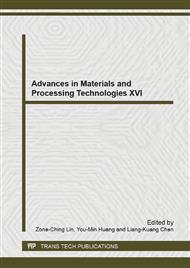p.459
p.465
p.473
p.481
p.491
p.499
p.506
p.517
p.524
Surface Roughness Measurements of a Narrow Borehole — Development of Stylus with Cylindrical Mirror and Lensed Fiber
Abstract:
In various industrial fields, it is frequently necessary to measure surface roughness in confined spaces such as boreholes and grooves. However, using a small stylus, the surface roughness of a narrow borehole can be directly measured only a few millimeters from its end; alternatively, destructive measurements must be performed. This major disadvantage of conventional stylus-based surface profilometers is mainly due to an inductive pick-up that is connected to the stylus used to detect the surface roughness. In this paper, we propose a novel surface roughness measurement sensor. To make the surface roughness sensor small, we used a stylus with a cylindrical mirror and a lensed fiber instead of a conventional inductive pick-up. The proposed sensor converts the signal obtained by measuring the surface roughness of a borehole into an optical signal, which is transferred outside the borehole by an optical fiber. Experimental results demonstrate that this system has a measurement range of 8 μm and a sensitivity of 19 nm. Surface profiles were measured by the proposed sensor and by a conventional surface profiler and the results were found to be very similar.
Info:
Periodical:
Pages:
491-498
Citation:
Online since:
May 2014
Keywords:
Price:
Сopyright:
© 2014 Trans Tech Publications Ltd. All Rights Reserved
Share:
Citation:


